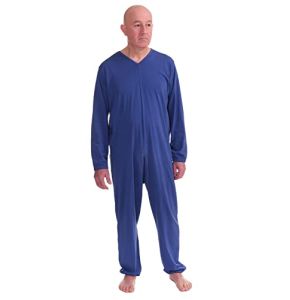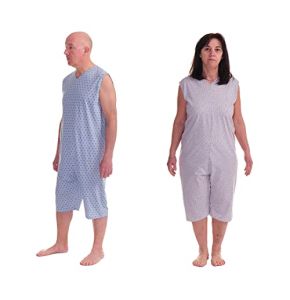Medical Sleep Sack
B01AW7JL2S
B09X1L3T53
B0B8K33VXV
B09YYXG6DR
B01N8U2R1A
Medical Sleepers: Safety and Comfort for Your Patients
The medical sleeper is an essential device in the healthcare field. It allows for the gentle immobilization of patients, especially children, during medical procedures. By ensuring patient safety, it facilitates the work of healthcare professionals. Let's explore the situations where its use is recommended, how to choose one, techniques for using it safely, its advantages over other immobilization methods, and the ethical considerations to keep in mind.
In which situations is the use of a medical sleeper recommended?
The medical sleeper is useful in numerous situations. It helps keep the patient immobile in a gentle and secure manner. Here are the contexts where its use is particularly recommended:
- Procedures Requiring Immobilization: During certain examinations or treatments, it is important that the patient remains still. The sleeper ensures effective immobilization without causing stress.
- Agitated or Anxious Patients: Nervous or confused individuals may have difficulty staying calm. The medical sleeper helps them feel secure and prevents sudden movements.
- Palliative Care: For end-of-life patients, comfort and dignity are paramount. The sleeper helps preserve their appearance and reduce discomfort related to soiling.
- Patients with Reduced Mobility: Patients with physical limitations may struggle to eat cleanly. Adult sleepers facilitate meals and prevent frequent clothing changes.
- Oral Care: During tooth brushing or dental care sessions, sleepers protect against splashes of toothpaste or mouthwash.
In summary, the medical sleeper is recommended whenever it is important to limit the patient's movements for their safety and the success of care.
How to Choose a Medical Sleeper Adapted to the Patient's Needs?
To ensure the sleeper is effective and comfortable, it is crucial to choose it carefully. Here are the elements to consider during your selection:
- Available Sizes: Ensure that the sleeper is suitable for the patient's size and weight. There are models for infants, children, and adults. A good size guarantees effective immobilization without discomfort.
- Comfortable Materials: The fabric should be soft and breathable to avoid skin irritations. Hypoallergenic materials are recommended for sensitive patients.
- Necessary Level of Restriction: Depending on the procedure, it may be necessary to immobilize only part of the body or the entire body. Choose a sleeper that offers the appropriate level of restraint.
- Ease of Use: The sleeper should be easy to install and remove. Practical fastenings, such as Velcro or zippers, facilitate the work of healthcare staff.
- Maintenance: Opt for a model that is easy to clean and disinfect. This ensures optimal hygiene between each use.
By considering these criteria, you choose a medical sleeper that meets the specific needs of the patient and ensures their safety.
What Are the Techniques for Using a Medical Sleeper Safely?
Correct use of the medical sleeper is important for patient safety. Here are the steps to follow:
Installation Methods
Place the sleeper flat on a stable surface. Lay the patient on it, aligning their shoulders with the top of the sleeper. Gently wrap the patient, adjusting the fastenings for secure but comfortable restraint. Ensure that the arms and legs are positioned correctly.
Patient Monitoring
Once the patient is installed, regularly monitor their comfort and vital signs. Check that they are breathing well and that there are no uncomfortable pressure areas. Stay alert to any signs of distress or discomfort.
Respecting Comfort
Talk to the patient to reassure them. Explain why the sleeper is being used. If the patient is a child, use simple words and a soothing voice. Ensure the sleeper is not too tight and that they can move slightly to avoid numbness.
By following these techniques, you use the medical sleeper safely and respectfully towards the patient.
What Are the Advantages of the Medical Sleeper Compared to Other Immobilization Methods?
The medical sleeper offers several advantages compared to other immobilization methods. Here are the main ones:
- Reduction of Stress: The sleeper gently envelops the patient, which can have a calming effect. It is less frightening than straps or more rigid devices.
- Prevention of Injuries: By limiting sudden movements, it prevents the patient from getting hurt or worsening their condition. It also protects healthcare staff from accidental strikes.
- Facilitation of Care: The sleeper allows easy access to the necessary areas for care. It does not hinder medical interventions while keeping the patient in place.
- Increased Comfort: The patient is maintained in a natural and comfortable position. Soft and breathable materials enhance well-being during use.
- Adaptability: The sleeper is suitable for different ages and sizes of patients. It can be used in various medical contexts.
These advantages make the medical sleeper a valuable tool for healthcare professionals seeking gentle immobilization of patients.
What Are the Ethical Considerations When Using a Medical Sleeper?
The use of the medical sleeper raises important ethical questions. Here are the points to consider:
- Consent: Always explain to the patient, or their relatives if they are a minor, why the sleeper is necessary. Obtaining their agreement is essential to respect their rights.
- Respect for Dignity: Use the sleeper in a way that preserves the patient's dignity. Avoid leaving them immobilized longer than necessary and ensure their comfort.
- Communication with the Patient and Family: Clearly inform them about the reasons for immobilization and the steps of the process. Answer questions and reassure them about any concerns.
- Proportional Use: The sleeper should be used only when necessary. Avoid any abusive or unjustified use of immobilization.
- Continuous Monitoring: Never leave a patient alone and immobilized without supervision. Ensure their well-being throughout the procedure.
By respecting these ethical considerations, you ensure responsible use of the medical sleeper, centered on the patient's well-being.
Conclusion
The medical sleeper is an important device to ensure patient safety during certain procedures. It offers a gentle and effective immobilization method, suitable for various contexts, especially in pediatrics. By choosing a sleeper adapted to the patient's needs and using it correctly, healthcare professionals can facilitate care while reducing stress and the risk of injuries.
It is essential to consider the ethical aspects related to its use. Respecting consent, dignity, and clear communication with the patient and their family are fundamental. The medical sleeper should be used with caution and always in the patient's best interest.
At Placemed, we offer a range of high-quality medical sleepers designed to meet the needs of patients and healthcare professionals. Our products combine comfort, safety, and practicality. Feel free to explore our catalog to find the sleeper that best suits your needs. Together, let's contribute to safer and more humane care.
 Francais
Francais 








